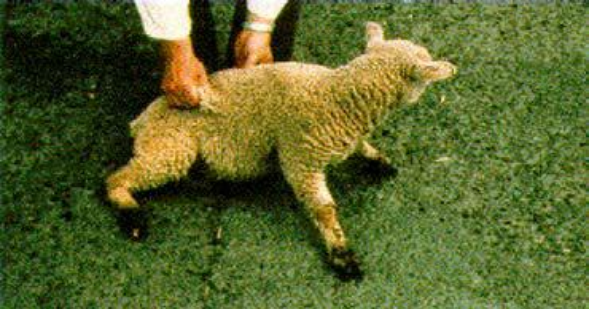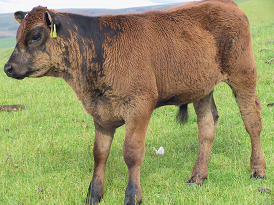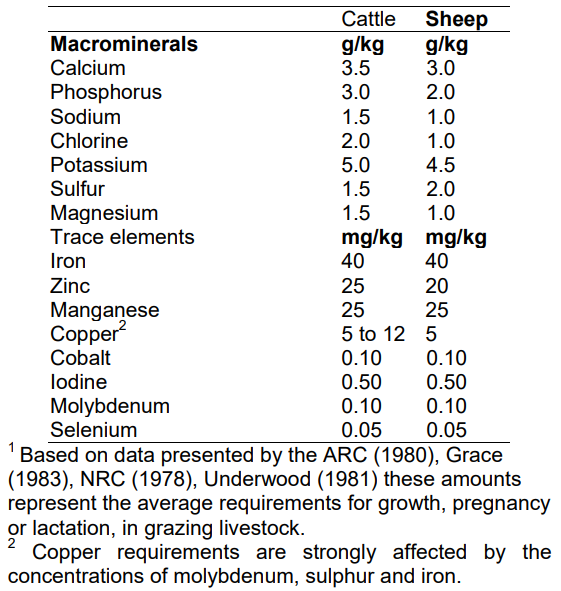Mineral Deficiencies in Sheep and Cattle
Trace elements (minerals present in living tissues in small amounts) are required for animal growth and production. Nutrient deficiencies in grazing animals can be caused by low trace element levels in plants or pasture. Mineral deficiencies commonly found in Victoria are Copper, Selenium and Cobalt.
In cases of animal deficiency or toxicity, it is more economical to treat individual animal health than to amend the land/pasture by application of expensive fertilisers/trace elements.
Trace Elements
Copper
Animals have a higher copper requirement than plants. It’s needed for body, bone and wool growth. Historical data on copper levels in pasture should be used as a guide only as fertiliser application may have changed the copper levels on individual properties. Ask your Ag Department regional contact for local detail on deficient areas.
Copper deficiency may occur in animals due to:
- Grazing for extended periods on green feed as copper is more readily available in dry feed
- Pasture type, as grasses have a lower copper level than clovers
- Seasonality in Victoria with deficiency more likely to occur in the winter-spring period and resolving itself during the summer months
- High dietary intake of other elements. Molybdenum and sulphur form a compound binding with copper which makes copper on it’s own unavailable to the animal.
Clinical Signs of copper deficiency may include:
- Rough coat in cattle or steely wool in sheep
- Fading of the coat, usually starting around the eyes. In cattle, this may include sandy coloured Herefords or a bronze coloured coat in Angus
- Poor growth and body condition in cattle
- Diarrhoea in cattle
- Swayback in lambs (loss of coordination and paralysis of the hind quarters)
Selenium
Selenium (Se) is an essential element for animals but not plants. It is required for growth and prevention of white muscle disease in lambs and calves. White muscle disease (myopathy) is a degenerative disease affecting the skeletal and cardiac muscles causing weakness and death. Selenium also plays a role in providing resistance to disease and reproductive efficiency such as fertility and reduced incidence of retained afterbirth (when all or part of the placenta is not delivered after lambing/calving).
Seasonal variation can impact selenium levels of grazing livestock, with the lowest levels occurring in spring and summer. Known selenium deficient areas have acidic soils, high rainfall (> 500ml annual rainfall) and pastures with high super phosphate application and clover dominance. The dietary requirement is 0.05 to 0.1 mg Se/Kg of sheep and cattle (table 1).
Newborns or young livestock are affected by Selenium deficiency due to their fast-paced growth and higher requirement for Selenium. White muscle disease is more common in Victoria in lambs as they have higher Selenium requirements than calves. Young stock are more affected during lush feed situations. White muscle disease in lambs and calves is more prevalent in years when there is good autumn rainfall and abundant supply of clover in spring.
Clinical Signs of selenium deficiency may include:
- Ill thrift in young cattle, sheep and goats
- Poor growth
- Reduced conception rates, especially in younger breeding heifers and ewes
- Reduced wool production
- Retained foetal membranes
- Stiff legged gait
Flocks experiencing significant cases of white muscle disease annually should administer a selenium supplement to:
- Rams and ewes prior to mating
- Ewes in mid to late pregnancy to ensure adequate selenium levels are transferred to the foetus
- Lambs at marking and weaning
Excess selenium can be toxic. For this reason, care should be taken when considering selenium supplementation of livestock and consult your veterinarian first.
Cobalt/Vitamin B12
Cobalt is essential for the production of vitamin B12 in the rumen. In plants cobalt is required in minute amounts by bacteria that fix nitrogen in legumes.
Cobalt, and therefore vitamin B12, deficiency can be seen in association with heavy application of lime and superphosphate fertilisers to pasture.
Seasonal variations in pasture cobalt levels are significant. Concentrations of cobalt in pastures and corresponding levels of vitamin B12 in livestock are lowest during the spring flush. This may be due to stock not ingesting soil when grazing lush, rapidly growing pastures. Soils provide a more concentrated source of cobalt for ruminants then pastures.
Cobalt deficiency in sheep and cattle occurs in soils measuring cobalt concentrations of less than 0.10 mg/kg dry weight (table 1). A blood test may be used to confirm deficiency but this is not widely available.
Animals deficient in cobalt and vitamin B12 may exhibit the following symptoms:
- Poor appetite
- Poor body condition
- Weeping ‘rheumy’ eyes
- Scaly ears
- Anaemia
- Decreased milk production
- Death in severe and prolonged cases
Immediate treatment for animals showing clinical signs of deficiency is a vitamin B12 injection, which may last up to 3 months depending on the level of the deficiency.
Young, growing animals and pregnant/lactating animals have the highest requirement for vitamin B12.
Prevention and Treatment
Mineral supplementations are available as injections, capsules (boluses), drenches, pour-ons or as loose licks depending on the mineral(s) to be supplemented. They can also be applied through fertiliser additives or pasture sprays but aren’t as effective at directly treating the animal. Before starting an intensive supplement program, it is recommended you consult with your local veterinarian or ruminant nutritionist.
It is useful to know what mineral deficiencies are common for your area. This information can be found by contacting your local veterinarian or Ag Department office for regional mineral deficiency data on 136 186 or find your local office number here.
Further Resources
- Agriculture Victoria – Trace mineral deficiencies
- Meat and Livestock Australia – Mineral deficiencies
- Victorian Resources Online – Trace elements for pastures and animals in Victoria
Click here to download the PDF version.
For further information, please contact the VFF Stock Sense team on 1300 882 833 or by email [email protected]


